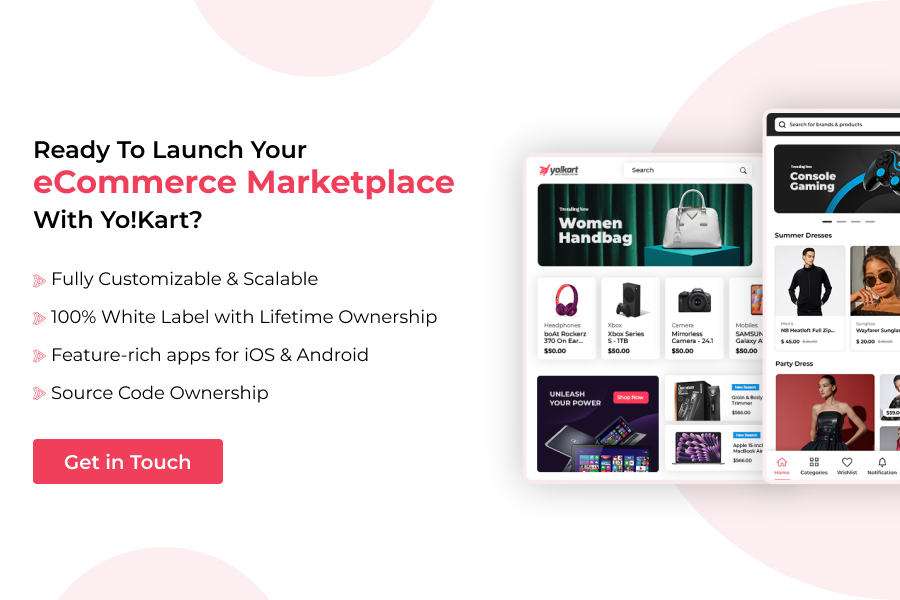Updated On: 30 Jun 2025
Initially, eCommerce was pioneered by horizontal marketplaces like Amazon, Alibaba, and others. They offer a wide assortment of products – from the best-selling smartphone to something unexpected like a rubber purse designed like a chicken! This variety still attracts a large number of consumers.
But their boon is also their bane i.e. lack of specialization.
This is where vertical marketplaces like Etsy have established an advantage – they offer a tailored ecosystem to a well-defined audience. The platform is purpose-built for a specific category of products. For example, Etsy is a platform for unique and creative products.
Moreover, in such cases, the business operations can also be designed around the target audience. For instance, Etsy is a peer to peer marketplace i.e. the sellers are also buyers and vice-versa. This provides ideal opportunities for solopreneurs, hobbyists, and independent sellers to use the platform. In essence, this is the concept behind the marketplace.
The $7.07B worth two-sided marketplace is an eCommerce success that continues to inspire businesses. So, in this blog, let’s draw inspiration from the phenomenon of Etsy and discover a step-by-step process of how to create an online marketplace like Etsy.
Table Of Contents
- Etsy’s Success Journey – Idea Borne by Identifying a Market Gap
- Etsy’s Success in Numbers
- Etsy’s Competitors
- What is the Business Model of Etsy?
- How does Etsy make money?
- Core Features of Etsy Driving Its Growth
- Etsy’s limitations: Opportunities for a competitive advantage
- Steps to Create an Online Marketplace Like Etsy
- Yo!Kart – Leading Turnkey eCommerce Marketplace Solution
- Yo!Kart-powered Etsy like e-marketplace platforms
- To Sum it Up
Etsy’s Success Journey – Idea Borne by Identifying a Market Gap
Etsy, as a concept, was borne out of an identified market gap. The founders, Robert Kalin, Chris Maguire, and Haim Schoppik, were website developers. They worked for clients operating in the handicrafts niche. Before Etsy came into being, such sellers primarily used eBay as a preferred platform to conduct their business. But, eBay catered to multiple product categories. This meant that the pain points of such sellers were left unaddressed.
This is where the founders found the opportunity i.e. to launch a platform that caters specifically to the needs of these sellers. So, in 2005, the marketplace was launched to address some key industry pain points. Some of these were higher commission rates, complexities in eBay, and more.
To make their platform stand out, the founders created an ecosystem wherein the sellers were provided with a more purpose-built platform to sell unique handicrafts. Henceforth, the marketplace gained traction right from its early days.
While the headstart did give the necessary initial impetus, multiple result-driven additions and strategies, have further helped the marketplace to navigate complexities and challenges all these years.
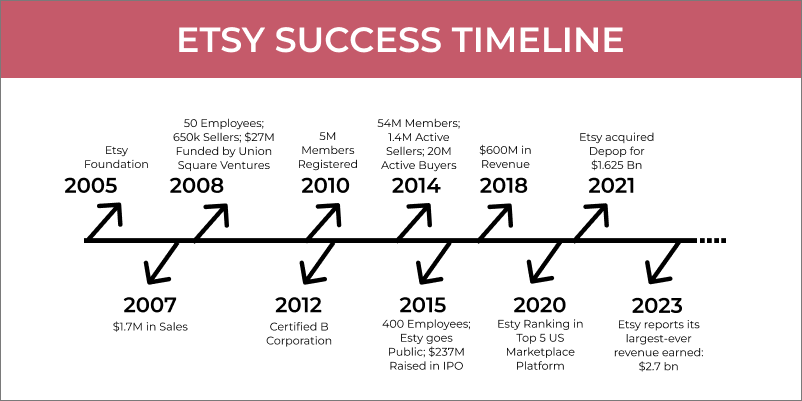
Suggested Read: Etsy’s enthralling journey from a Brooklyn apartment launch to 10 billion user strong platform.
Etsy’s Success in Numbers
The tangible success of a business is best expressed through its performance numbers. Let’s have a look at some data that reflects Etsy’s success.
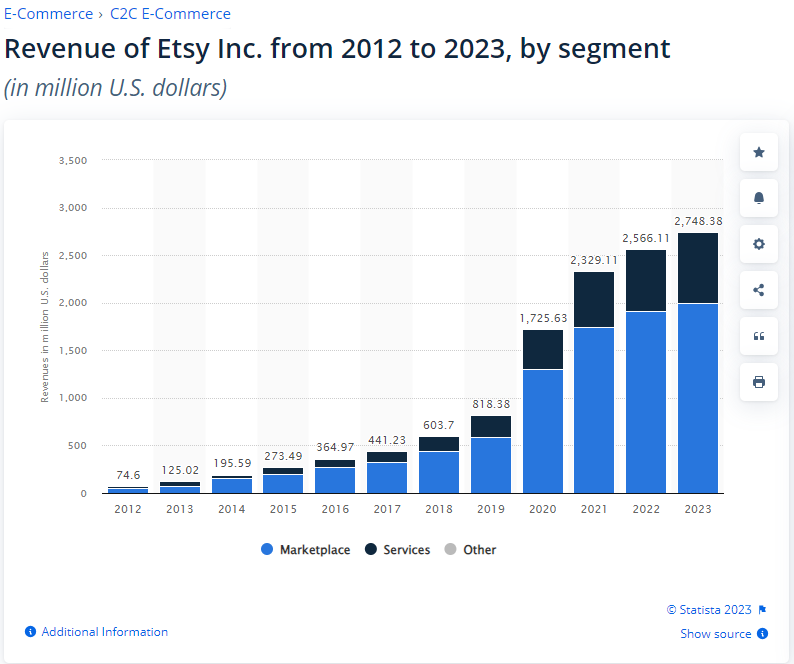
Source: Statista
Since its launch in 2005, the marketplace made steady progress until the year 2010, after which there was a sharp increase in revenue, only to be bolstered even further by the pandemic. This growth was due to both: the increasing traction of eCommerce during that period and Etsy’s strategies that bore results. Significantly, Etsy is still growing, with its largest ever-reported revenue coming in 2024.
The marketplace has steadily increased in popularity with its target audience making it the fourth fastest-growing eCommerce website. According to Statista, in 2021, the marketplace had about 7.5 million sellers selling 100 million listed products. The number of sellers on the platform is nearly the same with over 97 million buyers in the year 2024, which is a 40% increase since 2019. Moreover, it is still leading the DIY eCommerce market i.e. Etsy like websites built for DIYers.
Etsy’s Competitors
Etsy’s success as a handmade product sparked off a new industry in the retail landscape. Both established players and new startups turned their attention to this niche. Currently, the marketplace is competed by some of the following eCommerce marketplaces:
Amazon Handmade
There are very few niches in retail where Amazon’s name does not come up. In this industry as well, the retail behemoth competes with a Handmade marketplace. Amazon operates this business distinctly from its parent operations. The rules for sellers are separate than other product categories . The sellers are vetted carefully, and only those are onboarded who handcraft the products.
eBay
Interestingly, eBay was the marketplace before Etsy that handicraft vendors used to sell on. The marketplace remains one of Etsy’s major competitors. eBay operates differently than Etsy so their target market varies. Capabilities to auction remains one of the key differences.
Folksy
This is eCommerce marketplace similar to Etsy, but based out of United Kingdom. It follows a similar modus operandi as Etsy with a focus on fostering a community of artisans. However, a key differentiating factor is that its user base is from United Kingdom, so products available draw inspiration from the handicraft practices of the region.
What is the Business Model of Etsy?
With a name that roughly translates to Oh, yes! in Italian, Etsy has progressively reconfigured its strategies, ever since its launch. These have been an inspiration to Etsy like websites all over the world.
To make a website like Etsy, let’s first focus on its business operations, what are the key growth drivers, and how it generates revenue. Let’s read about that below.
The best suited business model for Etsy-like websites
Generally, an online marketplace with multiple sellers works as a digital tool that connects these sellers with buyers. While the backend operations and support are provided by the intermediary that owns the marketplace business. So the marketplace has three key participants: Admin (assigned by marketplace owners), sellers, and buyers.
Now depending upon the industry of the eCommerce platform, the target audience, and other factors, the business model of the eCommerce platform is structured. In Etsy’s case, since the sellers are solopreneurs, hobbyists, and other smaller businesses, the P2P business model was best suited. In such a business model, the platform offers ease of selling to sellers, making it convenient for sellers with little to no experience to operate with confidence.
This is how a P2P business model works:
1. The business sets up the online marketplace and backend eCommere operations like shipping, payment infrastructure, and more.
2. A marketplace operator is assigned Admin duties.
3. The marketplace operator configures the marketplace and invites users to onboard the marketplace platform.
4. The users can choose between signing up as a seller or a buyer. Those who wish to sell, can first sign up at the marketplace.
5. They set up their virtual shop on the P2P eCommerce platform and add bank account details.
6. Next, they list the products to be sold, assign prices for fixed-price items, or set up RFQ for negotiable items.
7. Now, those who wish to buy products, sign up as buyers.
8. They search for the products, add to their cart, and complete the checkout by paying for the order.
9. The payment is credited to the business account. The business deducts an applicable commission and transfers the remaining amount to the sellers’ bank account.
10. Finally, if you wish to create an Etsy like marketplace, shipping can either be the sellers’ responsibility, or the business can manage to pick and drop the products on their own.
Build an Etsy-like P2P Marketplace with Price Negotiation Functionality
To gain a quick overview of Etsy, let’s have a look at its business model canvas:
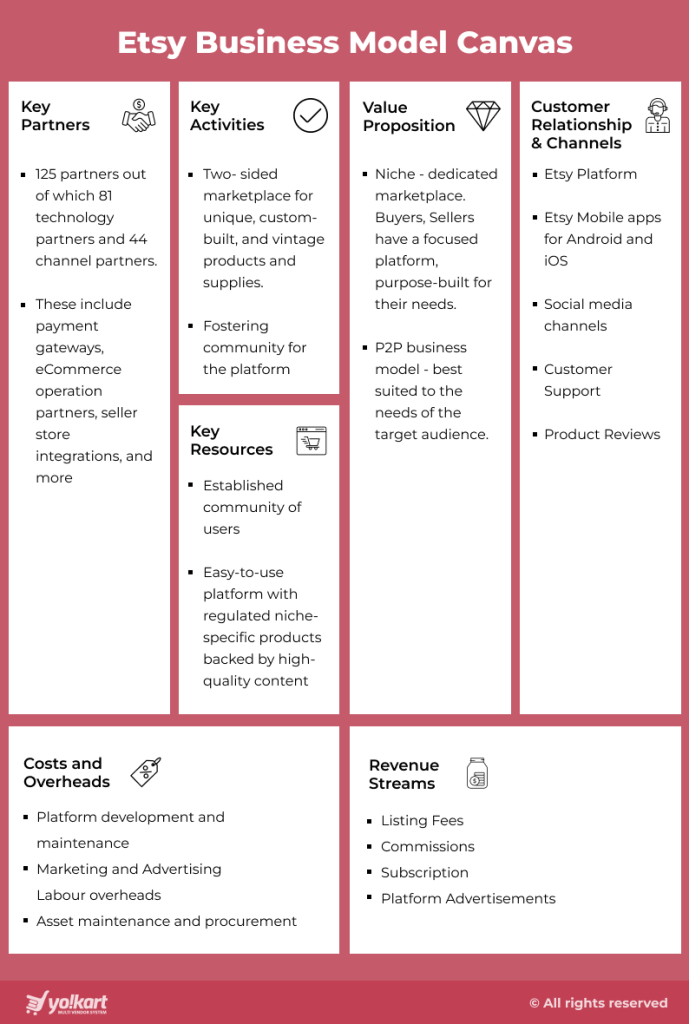
How does Etsy make money?
One of the biggest advantages of a multi-vendor marketplace model for the business owner is the opportunity to earn from multiple revenue channels. Etsy earns revenue from three primary revenue generation components that include:
- Etsy levies commission fees for all sales transactions and product listings
- “Etsy Plus” a paid subscription service for the sellers, gives them better features, adding to the revenue of the business.
- Etsy also monetizes ads on its platform. It allows sellers to post their ads, in exchange for a fee.
Additionally, if you plan to make a website like Etsy, a scaled-up business further provides opportunities to earn from allied activities. For instance, Etsy has some of the following additional sources of income:
- Etsy has acquired other businesses such as Reverb and Depop, further adding to its revenue streams.
- It offers a service called Pattern: With this service, it allows its sellers to launch their website, which is in addition to the Etsy shop. It charges the seller a monthly fee in exchange to this service.
Create Etsy Like Website with Multiple Revenue Streams
Core Features of Etsy Driving Its Growth
Features of a marketplace are subjective to its mode of operation. Since Etsy is a P2P eCommerce platform, that offers handicrafts and unique items, the features of the platform support activities of each participant ― the admin, sellers, and buyers. Let’s view the key features for each of these.
Features for Admin
The following are key features for the Admin in a P2P marketplace for handmade items like Etsy.
Support for Multiple Revenue Streams: While primarily multiple revenue streams add to the revenue generation, they also give flexibility to the eCommerce business. For instance, subscription-only plans encourage vendors to sell more, while commissions-only encourage more vendor sign-ups on the platform. A middle path can have a combination of both.
Content-driven Platform: Prioritizing quality content has been key to Etsy’s success. It was a key differentiator in its early days, driving traffic away from competitors to its platform. Moreover, as most products listed on the marketplace are unique, their appearance forms a major part of their USP. Hence, High-Quality Images with the option of multiple layouts and lucid product details are some key elements for an Etsy like site.
Complete Control for the Admin: With multiple sellers in the mix, it is the admin’s prerogative to manage the operations with complete control ― maintaining quality and ensuring the branding of the business. Especially, in this case, where the majority of sellers are small businesses. So regulating the marketplace effectively is a critical imperative in a P2P marketplace.
API-first Ecosystem: In an Etsy like site, multiple operations are possible via tie-ups with third-party service providers. The Business APIs for these service providers can be integrated with the platform, allowing effective eCommerce operations.
Features for Sellers
The following are key features for the Sellers in a P2P marketplace for handmade items like Etsy. Refer to the independent dashboard available to sellers on Etsy.

Source: Vantopics
Individual Seller Storefronts: Sellers on Etsy like marketplaces are primarily individual sellers. As discussed, these are smaller players looking to build their brand. Thus, the capability to set up individual storefronts offers them the opportunity to establish their brand identity―encouraging them to sell in the marketplace.
Product Catalog: A rich-featured and intuitive product catalog allows sellers to list their products effectively―showcasing them on the platform to enhance sales.
Detailed Analytics: Digital sales have the unique advantage of traceability. Data related to sales, traffic, user profiles, projections, and a lot more, support data-driven strategies and future planning.
Ease and Convenience: A key to attracting independent sellers and solopreneurs is a convenient onboarding and selling process on Etsy. Moreover, easy and efficient management of their operations enhances the appeal of the marketplace.
Features for Buyers
If you wish to make a website like Etsy, these features for buyers are pivotal to its success.
Detailed Authentic Reviews: In a P2P marketplace like Etsy, user reviews make up for a bigger impact than otherwise. As discussed, the majority of sellers are small businesses selling products that have little market presence. So authentic user reviews help buyers to make an informed purchase decision.
Multiple Payment Methods: A key to driving conversions in the modern eCommerce space is to offer multiple payment modes i.e. eWallets, Card payments, Cash On Delivery, and more.
Effective Search: With multiple, lesser-known products on sale, effective search capabilities are key to buyers landing on the intended page. Keyword-based search with filter options can be detrimental to the success of a P2P marketplace.
Features to Assist Community Build-up: P2P marketplaces like Etsy benefit from a strong community setup within the marketplace ecosystem. Some features that help in forming communities are:
– Direct seller-buyer communication
– Push notifications for buyers about seller activity
– Social media presence for the sellers. Sharing on social media can help sellers in this regard.
Get Etsy clone script with all essential features
Etsy’s limitations: Opportunities for a competitive advantage
While the DIY marketplace leads the industry landscape, it has some limitations. As an entrepreneur, considering to build a marketplace like Etsy, you can focus on these limitations―to start with a marketplace that offers additional value to its target audience.
Highlight Products/Shops
In a handmade marketplace like Etsy, all products don’t come from mass-market manufacturing i.e. there will be variation. Some products are created with more attention to detail. Moreover, some creators can craft products that appeal to the buyers more. In such scenarios, the marketplace can promote these products or shops by displaying tags such as “Top Rated Creator” or “Award Winning Creator” This helps buyers to discern the sellers/products more than their descriptions, leading to more satisfying shopping experiences. Moreover, sellers also have an incentive to offer better products.
Multiple Shipping Options
P2P marketplaces like Etsy have sellers who are independent creators or smaller businesses. For them, shipping prices play an important role in overall profit margins. Businesses that launch competitor P2P marketplace like Etsy, can offer curated shipping options for their users. Multiple options will help them in tailoring their shipping strategy. Eventually, this helps in better profit management, making the marketplace more attractive for sellers.
Bulk Discounts
Capabilities to offer discounted pricing if the order number is higher, helps the buyers to get more value in the prices. Similarly, the sellers get assured revenue with higher sales from a single source. Hence, this functionality is a useful addition for both sellers and buyers.
Dynamic Pricing
Since handicrafts may not have a fixed retail price like mass market products, the sellers wish to be more flexible with the pricing strategy. For instance, at times of the day when sales are expected to accelerate, they may want to lower prices for higher sales. Moreover, small/independent sellers dealing with limited inventory can find it difficult to offer a fixed price. For these reasons offering dynamic pricing can be an important inclusion in a DIY Marketplace.
Segregation of Digital Products
In addition to the physical products, Etsy also allows sellers to offer downloadable digital products. A common pain point is that buyers often confuse digital products with physical products, leading to unpleasant experiences for both parties. For this reason, marketplaces that want a competitive advantage over Etsy can curate a well-differentiated ecosystem on the platform.
Location-based Product Sorting
Again, considering the products on sale and the nature of sellers on a DIY platform, shipping can be both tedious and unfeasible for longer distances. For this reason, this feature can be a good addition. Buyers will only get to see products sold in a predefined local vicinity. If you plan to offer pick-and-drop service to your users, this feature will be even more critical.
Steps to Create an Online Marketplace Like Etsy
Until now we have discussed the business model of Etsy i.e. How it operates, and some key features that underpin its success. With this information, you can start to plan your business venture. Moving on, get an overview of how to create a website like Etsy with the following steps.
Step 1: Analysis and Market Research
To create a website like Etsy, conduct market research by adopting a three-pronged market research.
Business Positioning: Start with an analysis by identifying demand and supply gaps in the current market. Additionally, study the current industry trends, by delving into community forums and conducting market surveys. This will provide some critical market insights. Handmade and creative products are a niche within the eCommerce industry.
Existing Competition: The eCommerce industry has been getting competitive with brands pushing to get a piece of the online market share. An analysis of the existing competition ― both global and local, can help in identifying opportunities.
Understanding Buyers in the Domain: An analysis of the intended target audience of the business – their needs, current market gaps, products likely to trigger purchase decisions, and more can help you to build an idea. In a marketplace, both sellers and buyers need to be considered for a successful business – that offers value to all participants. For instance, Etsy has been built to provide a platform for a particular audience, as evident from the statistics below.
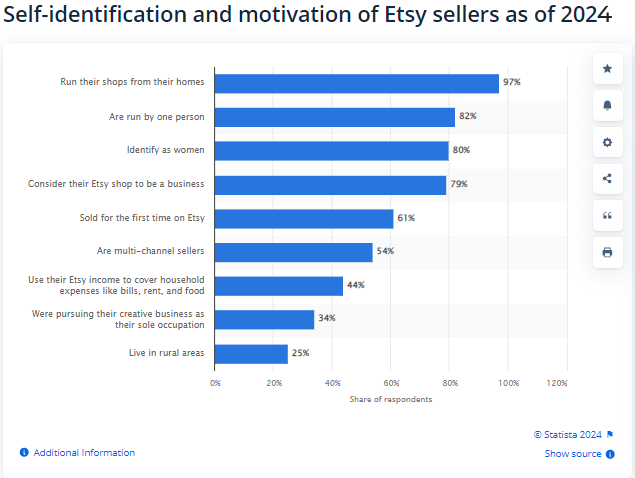
Source: Statista
Step 2: Decide on the Business Model
Most Etsy like businesses function with the P2P business model. However, as the industry progresses, there are opportunities for connecting consumers with businesses in a B2C marketplace. Based on your market research decide which business model works best for your idea.
Step 3: Decide Revenue Streams
By optimizing revenue streams available in a multivendor marketplace, the revenue generation can be tailored according to the business plan. Just like Etsy utilizes its revenue streams of commissions, listing fee, subscriptions, and paid advertisements, you can maximize your revenue through the available options. However, consider having flexibility to attract users on the platform. For instance, commissions can be lower, or listing fees can be minimized/waived for a limited time.
Step 4: Decide the best approach to build the website
The next step is to get down to create a website like Etsy, that will form the core of your business operations. There are two major approaches to do that.
Approach 1: Start building from scratch
To build the website from scratch, you either contact a custom website development company or hire a team. In this approach, the desired features have to be identified and included in the pre-launch phase.
This process is resource-intensive and time-consuming. Moreover, higher time would mean that the go-to-market time would be impacted. This can be a disadvantage in the dynamic eCommerce ecosystem – the longer you take to bring your business online after the initial market research, the more chances the research will become outdated. Moreover, you might lose the early-mover advantage in the identified market.
So what is the way out?
Approach 2: Use Turnkey Solutions – Reduce Costs, Expedite GTM
The easier approach is using readymade software. The software industry has many competitive turnkey solutions, each with its strengths and intended ideal use. These software provide competitive advantage of low upfront costs and less time to get up and running. You can conduct market research of these software to identify an ideal software with the requisite features to create a website like Etsy out of the box.
Yo!Kart – Leading Turnkey eCommerce Marketplace Solution
Yo!Kart is a self-hosted eCommerce marketplace solution. Yo!Kart offers key features of the solution are that are typically suited to an Etsy like eCommerce platform. Some of these are as follows:
| Your Business: Establish Unique Brand Identity |
Admin: Seamless Operational Efficiency |
Sellers: Effective Selling Tools |
Buyers: Intuitive Buying Experiences |
| High-Performing Platform | Intuitive Operational Workflows | Individual Seller Storefronts | Info-Driven Buyer Journey |
| Secure With GDPR Compliance | Extensive Reports and Analytics | Rich-Featured Product Catalog | Multiple Payment Options |
| User Dashboards for Admins, Sellers, Buyers, and Advertisers | Multiple Pre-integrated Business APIs | Effective Order Management With Returns & Cancellation | Buyer-Sellers Communication Channels |
| Integrated Blogging Module | Popular Payment Gateways | Result-Driven Marketing Features | Multicart Checkout |
| Availability of Multiple Revenue Streams | Inventory Management, Accounting | – | – |
Moreover, the solution is customizable and has the support of an in-house team. So additional functionalities can be added with ease.
Yo!Kart is also self-hosted and available with one-time payment packages. So with just one-time investment, you get complete ownership control and also own user data for your eCommerce platform. So getting started with a contemporary online marketplace is not just fast but also requires significantly less resources.
Yo!Kart-powered Etsy like e-marketplace platforms
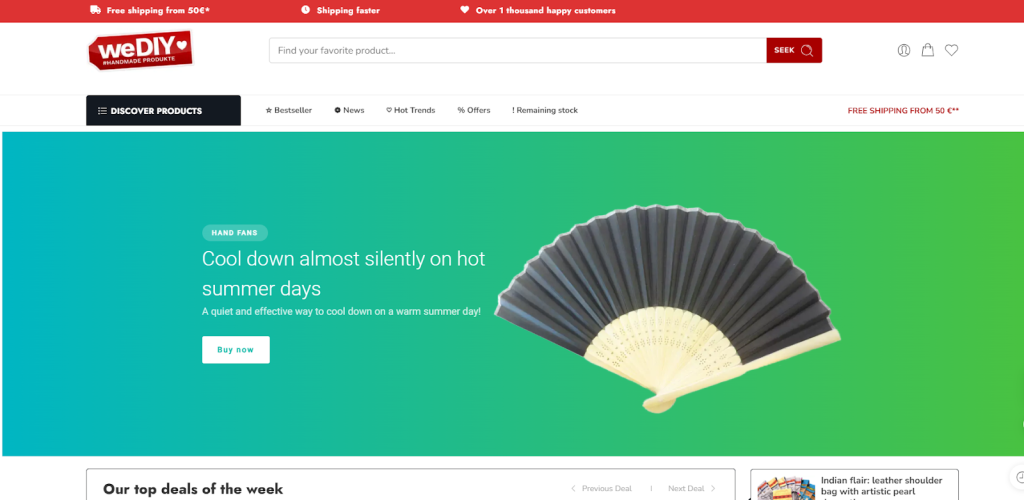
Yo!Kart has been at the heart of 5500+ stellar eCommerce marketplaces around the globe, powering their purpose-built websites. Some of these are Yo!Kart-powered Etsy-like online marketplaces. For instance, weDIY is a Germany-based eCommerce marketplace for creative and handmade products. It is powered by Yo!Kart. More such examples are Clic&Pic in France, Serjis in Latin America, and more.
Launch Your Own Marketplace Like Etsy
To Sum it Up
With the progression of technological advancements, eCommerce continues to attract more buyers. Markets across the globe are maturing to provide new entrants with good consumer traction.
Here niche-based businesses have been successful and continue to do so. Entrepreneurs can study the market with the right opportunity, and bridge a market gap with their business. A faster launch will further provide them with a competitive edge.
Also, by following the steps mentioned in this blog, you now know how to create a marketplace like Etsy. With Yo!Kart, businesses have the requisite capabilities to build a Etsy like marketplace in quick time. Moreover, with the availability of in-house customization, they can also get any specific business requirements catered to.
FAQ:
Q1. How difficult is it to create an online marketplace like Etsy?
Ans: If you create an online marketplace like Etsy from scratch, you will need time and resources. However, if you use a turnkey solution, the process can be simplified. Readymade turnkey solutions like Yo!Kart offers complete plug-and-play functionalities out of the box, which make starting with a marketplace like Etsy much easier. Moreover, any specific business requirements can be catered to with in-house customization services available with Yo!Kart.
Q2. How much will it cost to build an online marketplace like Etsy?
Ans: If you build an online marketplace like Etsy from scratch, the costs involved can reach anywhere from $50,000 to $200,000 or more, depending on multiple variables like the complexity of the website, the number of features to be added, the priority of your project, the expertise of your development partner, and more.
However, using a turnkey solution can help in undercutting these costs. You will still have a capable solution, but the costs incurred will be a fraction of this amount. Prices for readymade turnkey solutions like Yo!Kart starts from $499*. Get in touch with the team to get a self-paced demo.
Q3. How much time does it take to create a website like Etsy?
Ans: To create a website like Etsy from scratch, you need 6 to 12 months or more. However, by choosing a readymade peer-to-peer marketplace solution like Yo!Kart, you can build an online marketplace like Etsy in a few days or weeks.
Q4. What are the other popular platforms similar to Etsy?
Ans: There are many platforms similar to Etsy, including Poshmark, Vinted, Depop, Thred, eBay and Amazon Handmade.




